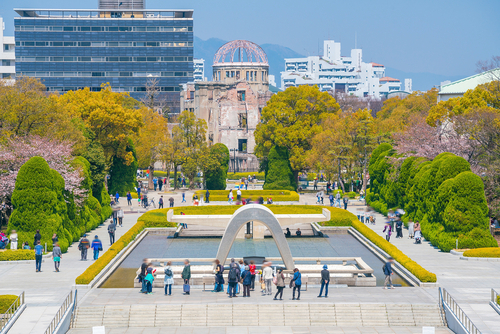- What is the Hiroshima Peace Memorial Park (平和記念公園)?
- Must-see spots in the Peace Memorial Park
- ①Atomic Bomb Dome (原爆ドーム)
- ②Hiroshima Peace Memorial Museum (平和記念資料館)
- ③Rest House(レストハウス)
- ④The Atomic Bomb Children’s Monument (原爆の子の像)
- ⑤Atomic Bomb Memorial Mound(原爆供養塔)
- ⑥Korean Atomic Bomb Victims Memorial(韓国人原爆犠牲者慰霊碑)
- ⑦Hiroshima Peace City Memorial (Atomic Bomb Victims Memorial)(広島平和都市記念碑(原爆死没者慰霊碑))
- ⑧Peace Bell (平和の鐘)
- A peace event held every August 6th
- Tips for more fun
- FAQs
- Nearby Attractions
- Essential Information
- Conclusion
What is the Hiroshima Peace Memorial Park (平和記念公園)?
It wasn’t originally a park…it was a town of about 4,400 people.
Hiroshima Peace Memorial Park (平和記念公園), located in the heart of Hiroshima, is globally recognized as the site where an atomic bomb was dropped during World War II.
This park was established to remember the tragedy of war and convey the importance of peace. It features numerous monuments and memorials, offering visitors a profound sense of history and hope for peace.
Founded in 1949, the park symbolizes Hiroshima’s post-war recovery. Today, it attracts millions of visitors annually and serves as a space for reflection and awareness about peace.
Must-see spots in the Peace Memorial Park
①Atomic Bomb Dome (原爆ドーム)
A symbol of Hiroshima Peace Memorial Park (平和記念公園), the Atomic Bomb Dome (原爆ドーム) is a remnant of a building that stood near the hypocenter of the atomic blast on August 6, 1945. Despite extensive damage, parts of the structure remained intact. Now a UNESCO World Heritage Site, it plays a crucial role in educating future generations about the horrors of war.

…For more details about
the Atomic Bomb Dome, click here.
②Hiroshima Peace Memorial Museum (平和記念資料館)
The Hiroshima Peace Memorial Museum (平和記念資料館) provides detailed insights into the devastation caused by the atomic bomb and the history of war. Its exhibits include personal belongings of victims, photographs, and testimonies, delivering a powerful message about the horrors of war and the significance of peace.

…For more details about
Hiroshima Peace Memorial Museum, click here.
③Rest House(レストハウス)
The only building in the park that still retains its appearance before the bombing has been renovated. Materials showing the state of the old Nakajima area(旧中島地区) before the bombing are on display, and you can also visit the basement where one person miraculously survived the bombing. There is also a tourist information center, rest area, shop, and cafe.
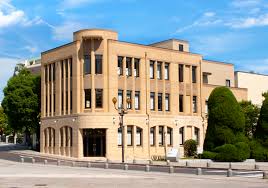
④The Atomic Bomb Children’s Monument (原爆の子の像)
This monument commemorates the children who died in the atomic bombing, including Sadako Sasaki(佐々木禎子), who died of leukemia. Sadako continued to fold cranes in hopes of recovering from her illness, and the cranes became a symbol of peace. Many visitors bring their own cranes to offer their prayers.
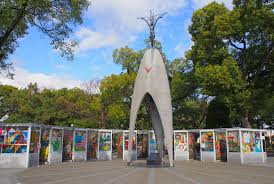
⑤Atomic Bomb Memorial Mound(原爆供養塔)
Inside the circular mound of earth are placed the remains of those who died in the atomic bombing, some of whom are unidentified and others whose entire families were wiped out and no one has come to claim them. Every year on August 6th, a joint memorial service that transcends religions is held in front of the mound.
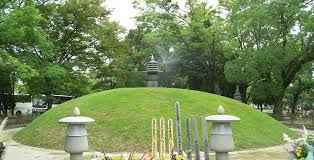
⑥Korean Atomic Bomb Victims Memorial(韓国人原爆犠牲者慰霊碑)
Thousands to tens of thousands of Koreans were killed, including those who were mobilized for forced labor and those who worked to make a living. As of August 2023, the names of 2,810 Koreans will be inscribed here.
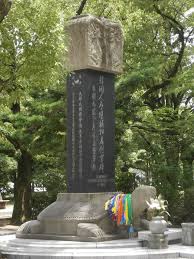
⑦Hiroshima Peace City Memorial (Atomic Bomb Victims Memorial)(広島平和都市記念碑(原爆死没者慰霊碑))
A memorial monument containing 125 volumes of lists of over 300,000 atomic bomb victims, both from Japan and overseas, and one volume with the inscription “Many names unknown.” At the G7 Hiroshima Summit, leaders of each country offered flowers here.


The Atomic Bomb Dome can be seen in a straight line from the Atomic Bomb Memorial.
⑧Peace Bell (平和の鐘)
The Peace Bell is a symbol of the movement to create a world free of nuclear weapons and war. Anyone can ring it.
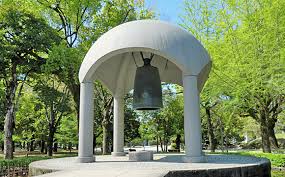
A peace event held every August 6th
Peace Memorial Ceremony
This ceremony commemorates the victims of the atomic bomb and prays for the realization of lasting world peace. After a moment of silence is observed at 8:15 a.m., the time the atomic bomb was dropped, the Mayor of Hiroshima makes a “Peace Declaration.”
Peace Message and Lantern Floating
This is an event where lanterns bearing wishes for peace are floated down the river. This event is held every year in a river near Hiroshima Peace Memorial Park, and lanterns with messages written on them from all over the world are floated down the river.
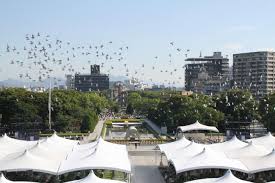
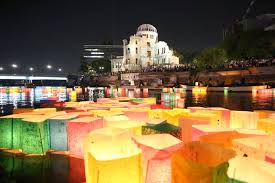
Tips for more fun
Make a folded paper crane
You can purchase origami paper at the Hiroshima Peace Memorial Museum gift shop and make folded paper cranes to donate to the museum or the Children’s Atomic Bomb Statue.
Approximately 10 million folded paper cranes are donated each year.
Listen to expert commentary
“Hiroshima Peace Volunteer” … You can have an explanation of the Hiroshima Peace Memorial Park with individuals or groups. They will explain things that are difficult to understand just from the guide boards.
The tour takes 1 to 1.5 hours. Advance reservations are required, but same-day reservations are also possible if there are spaces available. Free of charge.
FAQs
- QWhat is the estimated time for the tour?
- A
1 hour at Peace Memorial Park + 2 hours at Peace Memorial Museum – a total of 3 hours.
Nearby Attractions
Orizuru Tower (おりづるタワー)
Orizuru Tower is an observation point where you can see the city and the Atomic Bomb Dome. There is a floor where you can enjoy folding paper cranes and a shop with a wide selection of local souvenirs.
…For more details about the Orizuru Tower, click here.
Essential Information
Access:
- By Train: Approximately 15 minutes by streetcar from JR Hiroshima Station (JR広島駅), alight at Genbaku Dome-mae.
- By Foot: A 20-minute walk from Hiroshima city center.
- By Car: Accessible via the Hiroshima Expressway, with parking available nearby.
Fees and Hours:
- Hiroshima Peace Memorial Museum (平和記念資料館): Entry fee is 300 yen for adults and free for visitors under 18.
- Hours: 8:30 AM–6:00 PM (hours vary by season).
Official Website:
Visit the official website for Hiroshima Peace Memorial Park (平和記念公園) for more details.
Conclusion
Hiroshima Peace Memorial Park (平和記念公園) offers a unique opportunity to learn about history, reflect on peace, and enjoy its natural beauty. With its historical significance, cultural experiences, and convenient access, it’s a must-visit destination for anyone traveling to Hiroshima. Be sure to include it in your travel plans!

